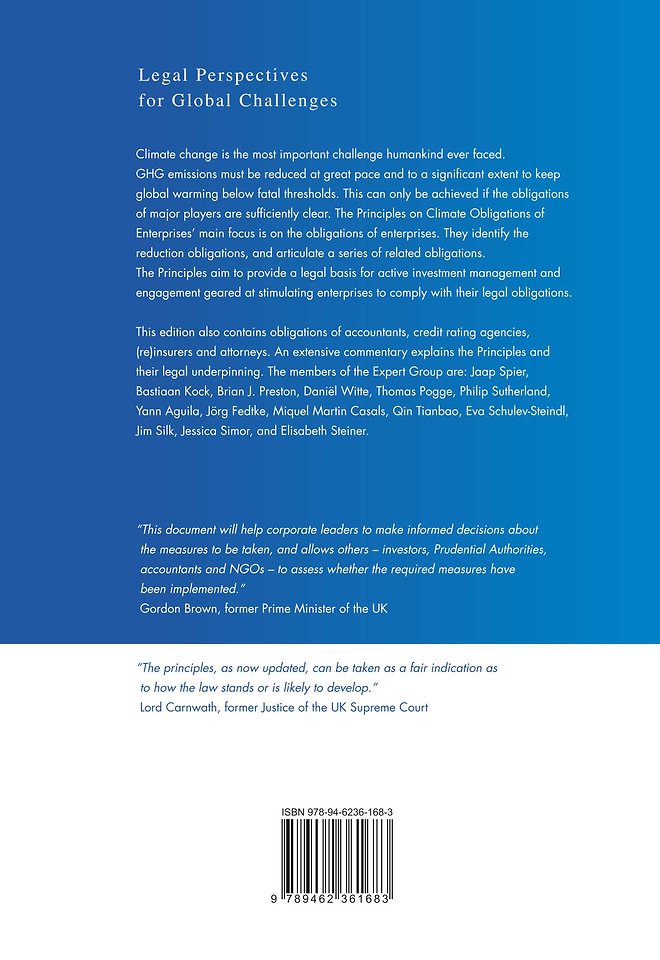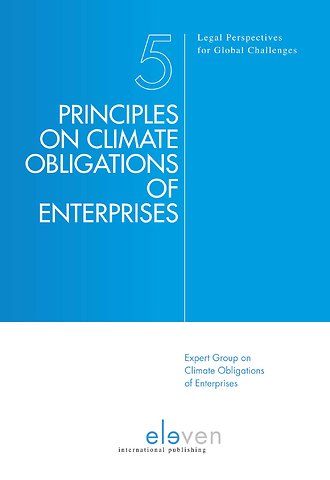Principles on Climate Obligations of Enterprises
(PDF-Download)
Samenvatting
Climate change is the most important challenge humankind ever faced. GHG emissions must be reduced at great pace and to a significant extent to keep global warming below 2 and preferably 1,5 degrees Celsius. This can only be achieved if the obligations of major players – States, enterprises and investors – are sufficiently clear.
The Oslo Principles aimed to discern the legal obligations of States. The Principles on Climate Obligations of Enterprises focus on the obligations of enterprises and investors. They identify the reduction obligations of enterprises, and articulate a series of related obligations. Investors can and many already do play an important role to stem the tide.
The Principles on Climate Change Obligations of Enterprises aim to provide a legal basis for active investment management and engagement geared at stimulating enterprises to comply with their legal obligations. An extensive commentary further explains the Principles and their legal underpinning. The members of the expert group are Thomas Pogge, Brian Preston, Tianbao Qin, James Silk, Jaap Spier (reporter), Elisabeth Steiner, Philip Sutherland and Daniël Witte.
Trefwoorden
Specificaties
Inhoudsopgave
PREFACES XVII
TEXT OF THE PRINCIPLES 1
I Definitions 1
II Enterprises’ GHG Reduction Obligations 3
III Consideration of Suppliers’ GHG Emissions 11
IV Advertising Products and Enticing Consumers 12
V Obligations of Buyers of Fossil Fuels 12
VI Supermarket Chains, Major Internet Sellers and Other Major Retailers 13
VII Outsourcing 13
VIII Effective Climate Governance 13
IX Enterprise’s Obligations of Disclosure 14
X Environmental Impact Assessment of New Facilities 16
XI Obligations of Investors and Financiers 16
XII Obligations of Insurers and Reinsurers 18
XIII Obligations of Accountants 18
XIV Obligations of Credit Rating Agents 18
XV Attorneys 19
XVI Exception for Hard Cases 19
GENERAL COMMENTARY 21
1 Members of the group 21
2 Our website 21
3 Concerned, and unprepared: the known knowns 22
4 Concerned and allegedly prepared 24
5 Ignorance 26
6 From global warming to climate crisis 26
7 Why an update? 28
7.1 A myriad of reasons 28
7.2 Global emissions still rising 29
7.3 Bleak forecasts 29
7.4 New scientific insights by the IPCC and others 31
7.5 Devastating natural catastrophes: the new “normal” 35
7.6 Developments in the political arena 36
7.7 The sobering conclusions of a ground-breaking report 37
7.8 Worse than expected 41
7.9 Conclusion 41
8 The purpose of the Principles 42
9 Promising initiatives 42
10 Why an emphasis on the corporate sector? 43
11 Key features: general observations 46
12 Key features: more emphasis on activities, products and services 47
13Key features: obligations of players in a position to bring about tangible change 49
14 Unwilling to take action: the costs are too high? 50
15 Vague Principles,laudableDeclarations, but concretisation important 53
16 Principles as concrete as possible 56
17 A special regime for fossil fuel enterprises? 59
18 Attribution of GHG emissions 60
18.1 Introduction 60
18.2 General discussion 61
18.3 Attribution of emissions from oil 63
18.4 Attribution of emissions from gas exploration, coal mines and fracking 63
18.5 Attribution of emissions from electricity production 64
18.6 Attribution of emissions from leakages 66
18.7 Exploration of new oil and gas fields 66
18.8 Deforestation 67
19 A circular economy? 68
20 The 2050 paradigm: aligning with the Paris Agreement: hoping for a bright future 68
21 Let us focus on what needs to be done in the ten years to come 69
22 Legal basis 70
22.1 Introduction 70
22.2 Polluter pays principle 72
22.3 Human Rights law 72
22.4 Minimum obligations 84
22.5 The Paris Agreement 87
22.6 The Paris Agreement as bare minimum 88
22.7 Tort law 91
22.8 Precautionary principle 95
22.9 Soft law as a legal basis 99
22.10 Pledges, declarations and the like as a basis for obligations 102
22.11 Obligations towards future generations 105
22.12 The state of the law 106
23 Not one size fits all 108
24 Not all or nothing 109
25 No bullet proof interpretation 109
26 Bold interpretation in case of doubt? 110
27 Gap filling obligations 110
28 The law as a living instrument 114
29 Role of courts 120
30 Climate change and the other sustainability goals 125
31 The temporal effect of the update 127
31.1 Historical emissions before the EP 127
31.2 From the EP to this update 130
COMMENTARY TO THE PRINCIPLES 131
Use of the previous version of the commentary 131
Principle 1 131
Definitions 131
Enterprises’ GHG emissions reduction obligations 148
Principle 2 148
General observations 148
Betting on negative emissions? 149
Alternative solutions? 149
All in all, the approach of Principle 2 preferable 150
Not all GHG emissions are unlawful 150
Emission trading schemes 151
Principle 2.1 151
Principle 2.1.1 153
A reality check 154
Dangerous GHGs 156
Increase and decrease of production and mergers and acquisitions: general observations 156
Increase of production 156
Decrease of production 158
Mergers and acquisitions 159
International transport 160
Calculation of reductions of enterprises in BPQ countries 162
Principle 2.1.2 162
Principle 2.1.3 162
Principle 2.1.4 163
Principle 2.2.1 164
Why five year periods? 165
The glidepath 165
The reduction percentage 167
Calculation of the NDCs of BPQ countries 167
A reality check 168
Principle 2.2.2 170
Principles 3 and 4:flexibility to determine the reduction obligations different 171
from Principle 2.1.1
Principle 3.1 172
Over-use of Principle 3.1 by countries 174
A non-exhaustive list 174
Principle 3.3.1 174
No carte blanche 174
Examples 175
A matrix of the respective factors 175
Border line cases difficult 176
Principle 3.3.2 176
Principle 3.3.3 176
Principle 4.1 177
Principle 4.2.1 179
Principles 4.2.2 and 4.2.3 179
Principle 4.3.1 179
Principles 4.3.2 and 4.3.3 180
Principle 5: General observations 180
Principle 5.1 181
Principle 5.2 182
Principle 6 182
Principles 7 and 8 183
Principle 7 183
Principle 7.1 184
Principle 7.2 185
Principle 8 186
General commentary on Principles 9 and 10 187
Principle 9.1 189
Principle 9.2 190
Principle 9.3 191
Principles 9.4 to 9.6 192
Principle 9.4 192
Principle 9.5 193
Principle 9.6 193
Principle 10 194
Principle 10.1 195
Principle 10.2 195
Principle 10.3 196
Principle 10.4 196
Principle 11 197
Principle 12 198
Principle 13.1 199
Principles 13.2 to 13.5 201
Principle 14 201
Principles 14.1(a), (b), (c) 202
Principle 14.1(d) 202
Principle 14.2 202
Principle 15 202
Principle 16 205
Principle 17 206
Consideration of suppliers’ GHG emissions 207
Principle 18 207
Principle 18.1 209
Principle 18.2 210
Principle 18.3 211
Principles 18.4 and 18.5 211
Principle 18.6 212
Advertising products and enticing consumers 212
Principles 19 and 20 212
Principle 19.1 213
Principle 19.2 213
Principle 20 214
Obligations of buyers of fossil fuels 214
Principle 21 214
Principle 21.1 215
Principle 21.2 216
Principle 21.3 216
Supermarket chains, major internet sellers and other major retailers 217
Principle 22 217
Principle 22.1 217
Principle 22.2 218
Principle 23: Outsourcing 219
Effective Climate Governance 220
Principles 24-26: general commentary 220
Legal basis 221
Shall or should? 228
How to assess the legal obligations? 228
Principle 24 229
Principle 25 232
Legal basis 235
Principle 26 237
Enterprise’s Obligations of disclosure 238
Principles 27 to 34: Disclosure 238
Legal basis 238
The importance of disclosure 239
Principle 27 240
Principle 28 243
Principle 29 243
Principle 30 246
Principle 31.1 248
Principle 31.2 248
Principle 32 249
Principle 33 250
Principle 34 251
Environmental impact assessments of new facilities 251
Principle 35 251
Principles 36 to 44: Obligations of financiers and investors: General 256
commentary
Ascertain and take into account 257
Obligations of financiers 257
Principle 36 257
The meaning of financier 258
The meaning of project 258
Legal basis 258
Differentiating between projects? 260
Principles 37 to 44: Obligations of investors: general commentary 262
Introduction 262
Legal basis 263
Principle 37 267
Principle 37.1 268
Principle 37.2 269
Principle 37.3 270
Principle 38 270
Principle 39 272
Principle 40 273
Principle 41.1 273
Principle 41.2 274
Principle 42 275
Principles 43.1 and 43.2 275
Principles 43.3 and 43.4 276
Principle 44 278
Principles 45 to 48: Obligations of insurers, re-insurers, accountants, credit rating agents and attorneys: General commentary 278
Principle 45: Insurers and re-insurers 279
Introduction 279
Liability insurance 280
Other insurance coverage 283
Principle 45.2 284
Principles 46 to 48: Obligations of accountants, credit rating agencies and 284
attorneys: General commentary
Principle 46: Accountants 285
Principle 47: Credit rating agencies 286
Principle 48: Attorneys 287
Principle 49: Exceptions for hard cases 289
Finally 290
Bibliography 295
Academic writings, books,reports, declarations, international instruments
Case law 339
International Courts and Commissions 339
National Courts 340
Non judicial case law 343
Anderen die dit e-book kochten, kochten ook
Rubrieken
- cadeauboeken
- computer en informatica
- economie
- filosofie
- flora en fauna
- geneeskunde
- geschiedenis
- gezondheid
- jeugd
- juridisch
- koken en eten
- kunst en cultuur
- literatuur en romans
- mens en maatschappij
- naslagwerken
- non-fictie informatief/professioneel
- paramedisch
- psychologie
- reizen
- religie
- schoolboeken
- spiritualiteit
- sport, hobby, lifestyle
- thrillers en spanning
- wetenschap en techniek
- woordenboeken en taal







